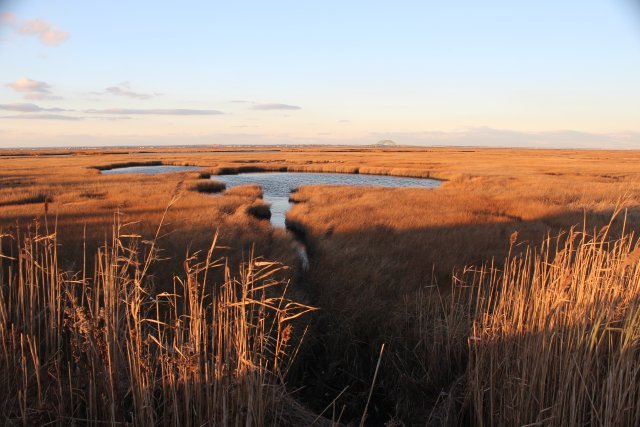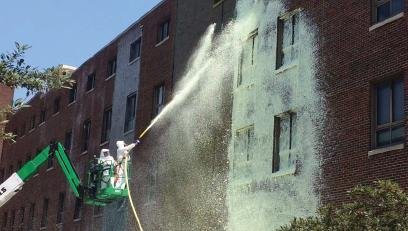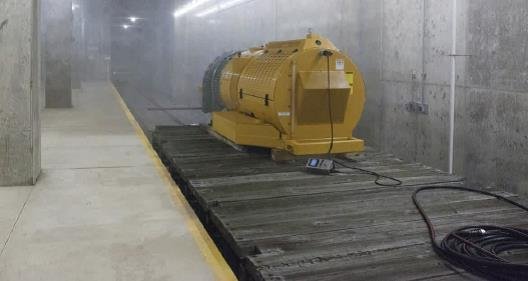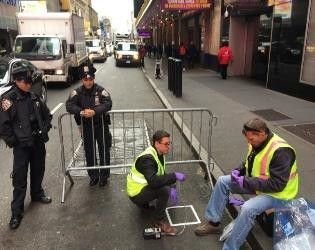EPA Research in New York
EPA researchers are working hard to protect communities across the nation. Learn about some of the work EPA researchers are doing in New York.
- Facilitating Closure of the Plum Island Animal Disease Center
- Long Island Sound Study
- Cleanup Following a Radiological Incident
- Ebola Decontamination
- Cleaning Up a Subway Contaminated with Anthrax
- Sampling After an Incident in NYC
- Real-Time Water Distribution System Analysis
- Emissions from Product Manufacturing Facilities
- Water Network Tool for Resilience
- EPA-Funded Technology Successfully Traces Renewable Fuel Supply Chain in New York City
- The Nitrogen Sensor That Could Change Residential Onsite Wastewater Treatment
- EPA’s COMET Tool Blazes a Path Towards Planning Cleaner Cities
- Evaluating the Effectiveness of Vacant Lots as Green Infrastructure in Buffalo, NY
- MARKAL Tool Designed to Help Cities Meet Environmental Protection Goals
For more EPA work, see EPA in New York.
Facilitating Closure of the Plum Island Animal Disease Center
Foreign animal diseases such as foot-and-mouth disease and African swine fever can have devastating effects on U.S. livestock industries, food security, and the economy. Since 1954, the Plum Island Animal Disease Center (PIADC) off of Long Island, New York, has served as a first line of defense against intentional introduction and naturally occurring, highly contagious animal pathogens within the United States. In 2008, the facility was found to have aging infrastructure and limited capacity to keep up with current animal agricultural research needs and it was decided to close the facility. EPA’s Office of Research and Development (ORD) is providing scientific support for closure activities through the Plum Island Closure and Support Program. Read the EPA Research Partner Support Story: Facilitating Closure of the Plum Island Animal Disease Center.
Long Island Sound Study

Since 1985, EPA has been collaborating with the Long Island Sound Study (LISS) partners in New York and Connecticut to protect and restore the sound. One of the most serious threats to water quality in Long Island Sound is nutrient input from the surrounding watersheds. Excess nutrients lead to algal blooms, acidification and lower oxygen levels in the water. EPA researchers in the Office of Research and Development (ORD) have served key membership and leadership roles on LISS committees and have collaborated on a host of projects to inform the LISS Comprehensive Conservation and Management Plan. For example, in 2014 ORD scientists headed the editorial team that produced Long Island Sound: Prospects for The Urban Sea, the first synthesis of the science of Long Island Sound in more than 35 years.
Cleanup Following a Radiological Incident

EPA researchers in the Office of Research and Development worked with colleagues at the Department of Homeland Security and the Department of Energy for the Wide Area Urban Radiological Containment, Mitigation, and Clean up Technology Demonstration. This highly successful event provided first responders, including representatives from New York City, with options for response to a wide area radiological incident, such as a dirty bomb explosion or a nuclear accident, by showing the responders the operation feasibility of the tools in real time while the end users deployed the technologies.
Ebola Decontamination
EPA researchers in the Office of Research and Development supported states, including New York, in responding to the 2014 outbreak of Ebola in the United States. EPA researchers provided technical support related to decontamination products and best ways to use them, and they recommended the best decontamination methods for Person Protective Equipment, which was important to health care workers and others who came into contact with Ebola patients. EPA also provided instruction on how waste contaminated with the Ebola virus should be managed and the fate of the virus in wastewater.
Cleaning Up a Subway Contaminated with Anthrax

EPA's Office of Research and Development is a leader in improving the nation’s ability to cleanup buildings contaminated with anthrax or other biological agents. In recognition of the complexities that would be involved, and the number of cities that have underground rail system, EPA along with Department of Homeland Security, Department of Defense and several national laboratories turned their attention to the cleanup of subway systems contaminated with anthrax. At Fort A.P. Hill, researchers evaluated decontamination technologies that could be used in the event of an anthrax incident in a subway system.
Sampling After an Incident in NYC

EPA researchers worked with NYC Department of Health and Mental Hygiene (DOHMH) and NYC Transit to answer key gaps in sampling after a large biological incident in a highly urbanized area. The project has resulted in an enhanced ability to conduct sampling and analysis operations for a large urban area following an anthrax contamination incident.
Real-Time Water Distribution System Analysis
EPA's tool EPANET-RTX gives water utilities the necessary tools to enhance system operations including emergency response and improved operations, e.g., better pressure management, leak detection and water quality. EPANET-RTX has been tested or demonstrated in several locations including Ohio, Colorado, Florida, Kentucky, and Michigan.
Emissions from Product Manufacturing Facilities
PFOA is a PFAS that was widely used as a processing aid to manufacture nonstick coatings (polytetrafluoroethylene [PTFE]) and other fluoropolymers. PFAS manufacturing facilities may emit PFAS and other volatile organic compounds (VOCs) into the air. At the request of the New York State Department of Environmental Conservation (NYSDEC), scientists from EPA’s Office of Research and Development (ORD) conducted an independent study to qualitatively identify PFAS and PTFE thermal degradation products in air emissions at a manufacturing facility in New York State where bulk PTFE is molded and sintered.
Water Network Tool for Resilience
EPA researchers and EPA Region 2 collaborated with he City and Town of Poughkeepsie, NY on a case study to use the Water Network Tool for Resilience (WNTR) to advance resilience. Using WNTR, they assessed a scenario involving the loss of source water to their treatment plant due to frozen intake pipes, drought, saltwater intrusion, or other events. The resulting analysis was shared with the city, who proposed to use the results to plan for and justify the costs of system upgrades that would enhance resilience over the long-term.
EPA-Funded Technology Successfully Traces Renewable Fuel Supply Chain in New York City
Renewable fuels, such as those made from corn or other biomass, offer a promising alternative to petroleum-based fuel. However, it is important to track fuel and the component feedstocks throughout the renewable fuel supply chain. EPA’s Small Business Innovation Research program recently supported Veriflux, a company that created an end-to-end technology platform that provides data and tracking to improve renewable fuel feedstock traceability. Read EPA-Funded Technology Successfully Traces Renewable Fuel Supply Chain in New York City.
The Nitrogen Sensor That Could Change Residential Onsite Wastewater Treatment
The winner of EPA's Advanced Septic System Nitrogen Sensor Challenge has developed a nitrogen sensor that could change residential onsite wastewater treatment. The winning prototype, called the Stony Brook Nitrogen Sensor, was developed by Dr. Qingzhi Zhu of Stony Brook University and the New York State Center for Clean Water Technology in Stony Brook, NY, to provide real-time nitrogen concentration and performance data on innovative and alternative systems, eliminating the need for expensive manual sample collection. Read From Challenge & Prize Competition to Test Prototype: The Nitrogen Sensor That Could Change Residential Onsite Wastewater Treatment.
EPA’s COMET Tool Blazes a Path Towards Planning Cleaner Cities
When building sustainable and smarter cities of the future, city planners must consider many factors including energy, environment, urban planning, and living standards. To equip local officials with the tools they need to find integrated solutions, EPA researchers designed the City-based Optimization Model for Energy Technologies (COMET). The first application of COMET was piloted in New York City, which has a goal to reach 80 percent greenhouse gas reduction relative to 2005 levels by 2050. Read EPA’s COMET Tool Blazes a Path Towards Planning Cleaner Cities.
Vacant Lots as Green Infrastructure in Buffalo, NY
Rainfall replenishes water supplies and keeps our urban landscapes green, but even small storms can cause localized flooding and inundate sewer systems. EPA researchers and partners determined the extent to which vacant lots around the city of Buffalo, NY, can function as green infrastructure by absorbing and filtering stormwater. Read Evaluating the Effectiveness of Vacant Lots as Green Infrastructure in Buffalo, NY.
MARKAL Tool Designed to Help Cities Meet Environmental Protection Goals
EPA researchers created an energy and water technology tool - called the Community-Scale MARKAL Model - to help cities and other municipalities make decisions on how to protect the environment, while also providing energy required for water services. Researchers used New York City as the pilot for developing the tool because the city has a tremendous amount of information collected on water and energy services in building, transportation, and utility sectors. Read New MARKAL Tool Designed to Help Cities Meet Environmental Protection Goals.
